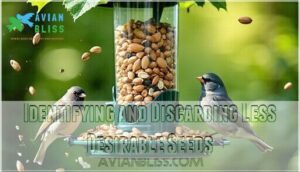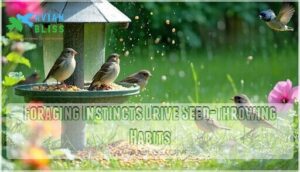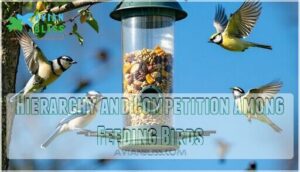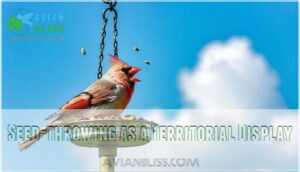This site is supported by our readers. We may earn a commission, at no cost to you, if you purchase through links.
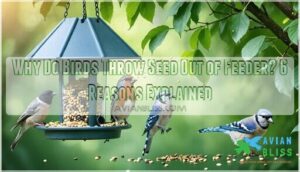
Birds don’t waste food – they’re selective eaters digging through mixed seeds to find their favorites. House finches reject 60% of mixed seeds to reach black sunflower seeds, while blue jays toss aside 75% of millet for peanuts and corn.
They’ll also discard empty, moldy, or poor-quality seeds that lack nutritional value. This "throwing" behavior actually helps ground-feeding birds like mourning doves access scattered seeds below.
Your feeder becomes a sorting station where birds practice survival skills learned in the wild, ensuring they get maximum nutrition from every meal. Smart feeder design and seed selection can dramatically reduce this natural behavior.
Table Of Contents
- Key Takeaways
- Birds’ Seed-Throwing Behavior: Natural or Wasteful?
- Seed Selection: Birds’ Quest for Quality
- Foraging Instincts Drive Seed-Throwing Habits
- Social Dynamics at The Bird Feeder
- Improving Bird Feeders to Reduce Seed Waste
- Frequently Asked Questions (FAQs)
- Why do birds throw food out of the feeder?
- Why do birds throw seeds out of feeders?
- Why do birds eat seed?
- Do birds eat seed thrown to the ground?
- Do birds eat birdseed?
- Why do bird feeders scatter on the ground?
- How often should bird feeders be cleaned?
- Can seed-throwing behavior attract unwanted pests?
- Do different bird species throw seeds differently?
- What time of day do birds visit feeders most?
- Conclusion
Key Takeaways
- You’re watching natural selection in action – Birds aren’t wasting food, they’re practicing quality control by discarding empty, moldy, or low-nutrition seeds while hunting for premium options like black oil sunflower seeds.
- Different species have specific preferences – House finches reject 60% of mixed seeds for sunflower varieties, while blue jays toss 75% of millet to reach peanuts and corn, explaining why your feeder looks messy.
- Ground-feeding birds benefit from the "waste" – When feeder birds scatter seeds, they’re creating feeding opportunities for mourning doves, sparrows, and juncos that prefer eating from the ground.
- You can reduce waste with smart choices – Choose spill-proof feeders with seed trays, offer single seed types instead of mixes, and buy high-quality seeds to dramatically cut down on selective throwing behavior.
Birds’ Seed-Throwing Behavior: Natural or Wasteful?
You’ve probably watched birds at your feeder and wondered why they seem to waste so much seed by tossing it to the ground.
This behavior isn’t actually wasteful but serves several important purposes, from finding the best quality seeds to following natural foraging instincts that have kept birds alive for millions of years, driven by their natural instinct to forage.
Observing Birds at Feeders
You’ve probably watched birds at your feeder and wondered why they’re such messy eaters.
This seemingly wasteful Bird Behavior actually reveals fascinating insights into their natural Feeding Habits. When you observe closely, you’ll notice birds aren’t randomly throwing seeds—they’re making calculated decisions based on Bird Preferences and Seed Quality.
Here’s what you’ll typically see at your feeder:
- Selective sorting through mixed seeds to find favorites
- Strategic digging to reach preferred seeds buried underneath
- Hull removal where birds crack open seeds and discard shells
- Quality control as birds reject moldy or poor-quality offerings
- Ground-feeding preparation where scattered seeds attract different species.
Understanding these bird feeding habits helps you improve your Feeder Design and bird feeder maintenance practices for better seed spill prevention.
Common Misconceptions About Seed-throwing
You’ve probably witnessed birds tossing seeds from your feeder and assumed they’re wasteful creatures.
Here’s the truth: what appears messy actually demonstrates sophisticated bird seed behavior and natural seed sorting instincts.
| Misconception | Reality | Impact |
|---|---|---|
| Birds waste food carelessly | They practice selective seed sorting | Promotes maximal nutrition |
| Poor feeder design doesn’t matter | Feeder design substantially affects waste | Better designs reduce spillage |
| All birds have identical preferences | Bird preferences vary by species | Targeted feeding improves satisfaction |
| Cheap seeds work fine | Seed quality determines acceptance rates | Higher quality reduces waste |
| Scattered seeds create problems | Ground feeders benefit from spillage | Natural seed dispersal methods work |
This behavior supports waste management through natural bird feeding habits and effective seed waste reduction strategies, which ultimately leads to better designs and higher quality seeds being used, resulting in maximal nutrition.
Ecological Impact of Scattered Seeds
Why do scattered seeds spell trouble for your yard? While seed waste might seem harmless, it creates real environmental challenges that affect your outdoor space.
- Seed pollution turns your pristine lawn into a sprouting mess of unwanted plants
- Soil degradation occurs when seed oils kill grass and alter soil chemistry
- Ecosystem disruption happens as invasive plants crowd out native species
- Wildlife attraction brings rodents and pests that damage your garden’s balance
Proper bird feeder care and seed waste reduction protect your yard from these issues while supporting healthy bird seed behavior.
Understanding the importance of seed dispersal patterns can help mitigate the negative effects of scattered seeds.
Seed Selection: Birds’ Quest for Quality
You’ve probably noticed birds acting like picky eaters at your feeder, tossing seeds left and right in their search for the perfect snack.
This selective behavior isn’t wasteful—it’s actually smart survival instinct where birds prioritize high-energy, nutritious seeds that give them the best bang for their buck.
Nutritional Preferences of Different Bird Species
Birds aren’t just grabbing random seeds—they’re making calculated choices based on their Nutrient Needs. Different species have distinct Seed Preferences that match their biology and Bird Diet requirements.
| Bird Species | Preferred Seeds | Rejection Rate |
|---|---|---|
| House Finches | Black sunflower seeds | 60% of mixed seed |
| American Goldfinches | Nyjer seed | High for large grains |
| Blue Jays | Peanuts, corn | 75% reject millet |
| Mourning Doves | Safflower, cracked corn | Ignore millet/canary |
| Chickadees | Sunflower hearts | 90% avoid sorghum |
Your Feeder Design and Seed Quality matter because birds seek protein-rich options during breeding season and high-fat seeds for winter survival.
Identifying and Discarding Less Desirable Seeds
Quality matters when you’re watching birds sort through your feeder offerings. Seed Quality drives their selective behavior as they expertly identify subpar options.
Birds demonstrate remarkable Seed Sorting skills, discarding items that don’t meet their standards:
- Empty or immature seeds lacking nutritional kernels
- Moldy or deteriorating seed types with potential health risks
- Filler grains like milo and wheat with poor energy content
This natural seed selection guide helps reduce seed wastage while optimizing Bird Preferences through strategic Feeder Design choices.
Understanding the importance of seed dispersal patterns affects bird behavior is essential for maintaining a healthy and efficient bird feeding environment.
Seasonal Variations in Seed Preferences
Throughout the year, your feeder becomes a seasonal restaurant with an ever-changing menu. Bird migration and seasonal diet shifts drive these preferences, making seed choice essential for attracting different species.
Here’s how bird seed preferences change with each season:
- Winter: Black oil sunflower seeds provide double the calories of hulled varieties, while suet’s high fat content helps birds survive freezing nights
- Spring: Protein-rich mealworms and high-quality sunflower seeds fuel nesting activities and chick development
- Summer: Smaller portions of premium seeds like Nyjer prevent spoilage, while fresh water becomes essential for dehydration prevention
- Fall: Fat-rich peanuts and nut blends help birds build energy reserves for upcoming migrations
- Year-round: Seed quality trumps quantity – fresh, non-moldy options always win over cheap filler grains
Understanding these bird behavior patterns helps explain why birds reject certain seeds seasonally, improving your seed selection guide success. When choosing the right seeds, consider the seed types available to attract the desired bird species to your feeder.
Foraging Instincts Drive Seed-Throwing Habits
You’ve probably watched birds at your feeder and wondered why they seem to waste so much seed by flicking it onto the ground.
This behavior isn’t actually wasteful—it’s a deeply ingrained foraging instinct that helped their ancestors survive in the wild, which is a foraging instinct.
Natural Foraging Behaviors in The Wild
The wild holds nature’s blueprint for understanding bird behavior patterns.
When you watch birds in forests or fields, they spend 6-18 hours daily using natural foraging behaviors to survive.
Wild foraging involves constant seed sorting – birds dig, scratch, and kick through materials to find premium options.
Birds scratch and dig through seed piles just like they would on forest floors—it’s pure survival instinct
These foraging strategies evolved over millennia, with bird migration patterns reinforcing selective feeding habits across seasons.
Birds exhibit natural foraging behavior that’s essential to their survival and well-being.
Adapting Foraging Techniques to Bird Feeders
Your backyard feeder presents a fascinating puzzle for birds who must adapt their wild foraging strategies to artificial feeding stations.
They’ll instinctively scratch and kick seeds like they’re searching forest floors, even when perched on elevated feeders. This bird behavior creates significant seed loss as their natural feeding habits clash with feeder design.
Understanding these foraging strategies helps explain why you’ll see birds methodically sorting through mixed seeds, tossing unwanted varieties while seeking preferred options. Their bird feeding strategies haven’t evolved for our convenience.
- Ground-feeding birds kick seeds instinctively, mimicking natural scratching behaviors
- Chickadees and nuthatches carry seeds away, following wild caching instincts
- Seed quality assessment involves physical manipulation and testing
- Bird feeder placement affects how intensely birds exhibit natural behaviors
- Feeder maintenance becomes essential when natural habits increase waste
Seed-throwing as a Survival Strategy
Throwing seeds isn’t wasteful—it’s smart survival. Birds use selective seed selection to maximize nutrition while conserving energy.
This foraging tactic mirrors wild behaviors where survival instincts drive food choices. Poor seed quality gets tossed, while premium options stay.
Bird preferences vary by species, making feeder design essential for reducing seed wastage. Understanding the importance of seed dispersal strategies can help explain why birds engage in this behavior.
| Survival Strategy | Bird Species | Purpose |
|---|---|---|
| Energy Conservation | Cardinals, Chickadees | Discard low-nutrition seeds |
| Quality Control | Finches, Nuthatches | Select high-fat content |
| Competitive Advantage | Jays, Woodpeckers | Claim best food sources |
| Risk Management | Sparrows, Wrens | Avoid moldy/spoiled seeds |
| Efficient Foraging | All Species | Maximize caloric intake |
Social Dynamics at The Bird Feeder
You’ll notice that bird feeders become bustling social hubs where competition and hierarchy shape which birds get first access to premium seeds.
When dominant birds toss out less desirable seeds, they’re not just being picky—they’re also inadvertently creating a feeding opportunity for ground-dwelling species like sparrows and juncos below.
Hierarchy and Competition Among Feeding Birds
Bird dominance shapes every feeder interaction you’ll witness.
Size determines the pecking order, with larger species consistently displacing smaller ones for prime feeding spots.
Here’s what drives feeder hierarchy:
- Body size rules – Cardinals outrank finches, blue jays dominate sparrows
- Group power – Chickadee flocks can challenge solitary larger birds
- Species aggression – House sparrows punch above their weight class
- Winter intensifies – Cold weather sparks fiercer seed competition
- Same-species battles – Goldfinches fight goldfinches more than other birds
This bird dominance creates predictable foraging strategies where subordinate species wait their turn or feed during off-peak hours.
Seed-throwing as a Territorial Display
At the feeder, seed throwing becomes a power play—birds scatter seeds strategically to claim their turf.
This territorial marking establishes feeder hierarchy through dramatic displays.
Dominant birds use seed dominance as bird communication, showing who’s boss through social behavior.
- Aggressive seed flinging with exaggerated movements
- Chest-puffing displays while perched prominently
- Loud territorial calls during feeding sessions
- Wing-spreading postures to appear larger
- Blocking access to choice feeding spots
This territorial behavior helps establish pecking order at your feeder station.
The birds’ actions are influenced by their natural bird territorial displays to defend resources.
Sharing Food With Ground-feeding Birds
Despite the mess below your feeder, those scattered seeds serve an essential purpose in nature’s food chain.
Your feeder birds aren’t being wasteful—they’re inadvertently creating opportunities for ground-feeding birds through natural food sharing.
Bird behavior shows this seed preferences system benefits everyone involved.
| Feeder Birds | Ground-Feeding Birds |
|---|---|
| Cardinals, chickadees | Mourning doves, juncos |
| Blue jays, nuthatches | House sparrows, towhees |
| Goldfinches, finches | Dark-eyed juncos, quail |
| Woodpeckers, titmice | Ground doves, blackbirds |
| Tree sparrows, siskins | Song sparrows, thrashers |
This ground feeding partnership reduces seed wastage while supporting diverse species with different feeding styles.
Improving Bird Feeders to Reduce Seed Waste
You don’t have to live with the frustration of watching expensive birdseed scattered all over your yard.
By making smart adjustments to your feeder setup and seed choices, you can dramatically reduce waste while keeping your feathered friends happy and well-fed.
Designing Spill-proof Feeder Structures
Smart feeder design cuts seed waste dramatically. Choose feeders with built-in catching systems that work like safety nets for messy eaters. Using spill proof feeders can substantially reduce seed loss.
Here are five game-changing spill proof features:
- Weighted perch feeders close access ports when squirrels arrive
- Cylinder feeders with seed trays capture 50% more fallen seeds
- Tube feeders with narrow openings reduce sorting by 32%
- Feeder roofs shield seeds from rain and wind damage
- Multi-compartment models separate seed types, preventing excessive sorting
These bird feeder designs transform chaotic feeding into organized dining.
Offering a Variety of Seed Types
Beyond designing better feeders, you’ll find success by matching your seed selection to the birds you want to attract.
Different species have distinct preferences that drive their foraging habits. Understanding various bird seed types is essential for creating an effective bird-friendly environment.
| Seed Type | Preferred Birds | Nutritional Value |
|---|---|---|
| Black oil sunflower | Cardinals, chickadees, finches | High fat, protein-rich |
| White millet | Sparrows, juncos, doves | Carbohydrates, fiber |
| Safflower | Cardinals, chickadees | High protein, moderate fat |
| Nyjer | Goldfinches, siskins | High fat, small size |
Quality matters more than quantity. Premium blends reduce waste since birds won’t discard seeds they actually want to eat.
Positioning Feeders for Optimal Bird Access
Feeder placement can make or break your bird-feeding success. Position feeders 3-6 feet high for ideal bird visibility and seed accessibility.
Place them near natural cover but away from hiding spots where predators lurk. Yard layout matters—sheltered locations reduce wind-driven seed loss while maintaining clear sightlines.
Smart feeder height accommodates both perching and ground-feeding species. Regular feeder maintenance includes checking placement seasonally, ensuring your setup attracts maximum avian visitors.
Understanding proper feeder placement techniques is vital for an effective bird-feeding strategy.
Frequently Asked Questions (FAQs)
Why do birds throw food out of the feeder?
You’re seeing birds sort through seeds, tossing out low-quality or unwanted varieties to find their favorites. They’ll discard cheap fillers, empty hulls, and moldy seeds while searching for premium options.
Why do birds throw seeds out of feeders?
Birds toss seeds because they’re picky eaters searching for their favorites.
You’ll notice them sorting through mixed seed to find premium options like sunflower seeds, discarding fillers and poor-quality items they don’t want.
Why do birds eat seed?
Like fuel for a car, birds eat seeds to power their daily activities.
You’ll find they need the fats, proteins, and carbs packed inside seeds for energy, growth, and survival through harsh seasons.
Do birds eat seed thrown to the ground?
Yes, you’ll find ground-feeding birds like sparrows, mourning doves, and juncos happily eating seeds that’ve fallen from your feeders. It’s nature’s cleanup crew at work!
Do birds eat birdseed?
You’ll find that birds enthusiastically consume birdseed – it’s their preferred fast food.
They’ll munch on black oil sunflower seeds, safflower, and nyjer with gusto, discarding only the inedible hulls afterward.
Why do bird feeders scatter on the ground?
You’ll find scattered seeds because birds sort through offerings, tossing aside low-quality or unwanted varieties while hunting for their favorites. They’re also naturally messy eaters who accidentally spill seeds.
How often should bird feeders be cleaned?
Keeping feeders spotless isn’t rocket science, but consistency matters most. You’ll want to clean them every two weeks during normal use, or weekly when it’s hot and humid outside.
Can seed-throwing behavior attract unwanted pests?
Scattered seeds beneath your feeder create a buffet that attracts squirrels, rats, mice, and other unwanted critters.
They’ll keep coming back for easy meals, turning your peaceful bird sanctuary into a pest magnet.
Do different bird species throw seeds differently?
Like conductors sorting their orchestra, different bird species each have their own seed-throwing techniques. Ground feeders naturally kick and scratch, while chickadees and nuthatches carefully select favorites, discarding rejects.
What time of day do birds visit feeders most?
Birds typically visit feeders most actively during early morning hours (dawn to 10 AM) and late afternoon (3-6 PM). You’ll spot peak activity around sunrise when they’re hungriest after fasting overnight.
Conclusion
While many people see scattered seeds as wasteful mess, birds actually demonstrate remarkable intelligence through this behavior.
Understanding why do birds throw seed out of feeder reveals sophisticated survival strategies at work.
You’re witnessing quality control, social dynamics, and foraging instincts that’ve helped birds thrive for millions of years.
Rather than fighting this natural behavior, you can work with it by choosing appropriate feeders and high-quality seeds that match your local birds’ preferences, which involves understanding their preferences.
- https://www.youtube.com/watch?v=2Q5Mvi5JJU4
- https://feederwatch.org/blog/what-are-they-doing-with-all-those-seeds/
- https://pmc.ncbi.nlm.nih.gov/articles/PMC11033522/
- https://www.gardeningknowhow.com/garden-how-to/beneficial/problems-with-bird-seeds.htm
- https://www.birdforum.net/threads/birds-knocking-seeds-to-ground.384992/


